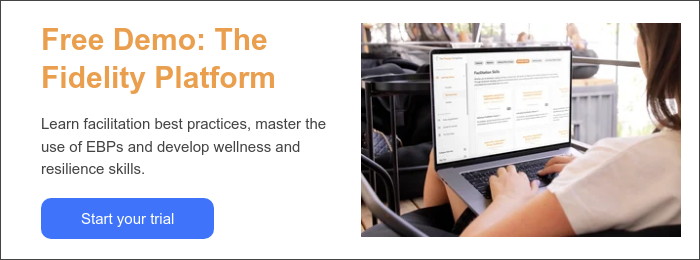5 Recommendations for Promoting Staff Mental Health and Well-being in Correctional Settings

In 2022, Surgeon General Vivek Murthy released a comprehensive framework for workplace mental health and well-being. This document outlines five essentials of worker well-being shared across industries and roles:
- Protection from Harm
- Connection and Community
- Work-Life Harmony
- Mattering at Work
- Opportunity for Growth
The correctional field can be an especially challenging workplace environment to establish these essentials. Day-to-day stressors can lead to mental health challenges, and these can be exacerbated by a perceived lack of support, stigma about discussing mental health and lack of awareness on how to cope in healthy ways. Challenges like these can have a direct impact on work performance, impeding individuals’ ability to respond effectively in high-stress situations and leading to consequences like anxiety and depression, substance misuse, sleep deficiency and relationship challenges.
How, then, can correctional leadership foster a workplace culture that supports staff mental health and well-being? The five essentials provide the framework, yet additional guidance is needed for how to fit this framework in this unique work environment. This article summarizes a few best practices that align with this framework. While not comprehensive, they may spark strategic discussion in individual agencies on how to enhance worker well-being in their unique settings.
Essential 1: Protection From Harm
Overview: “The first Essential of this Framework is Protection from Harm. Creating the conditions for physical and psychological safety is a critical foundation for ensuring workplace mental health and well-being. This Essential rests on two human needs: safety and security.”
Ideas for incorporating this essential include:
- Normalize and support mental health by training select staff on “mental health first aid,” talking publicly about the value of mental well-being and communicating that seeking help is a sign of strength, not weakness.
- Offer Employment Assistance Programs (EAPs) to give staff options for addressing concerns and to communicate that mental health matters in your agency.
- Build mental health and well-being into standard procedures and policies. Ask for feedback on how these policies and procedures are working and solicit recommendations across races, genders, ages and roles within your agency.
- Build processes for support after critical incidents into your culture, whether by hiring mental health professionals or liaising with professionals in the community.
Essential 2: Connection and Community
Overview: “The second Essential of the Framework is Connection and Community. Fostering positive social interactions and relationships in the workplace supports worker well-being. This Essential rests on two human needs: social support and belonging.”
- Create a culture of inclusion and belonging by modeling prosocial behavior. Try to regularly form meaningful connections with staff. Do you know the names of their loved ones? Are you familiar with their interests, hobbies and unique challenges? Forming connections that go beyond job descriptions can help staff feel supported and provide a model for connection that others can replicate.
- Establish clear communication processes between workers and leaders. Build in formal one-to-one interactions and make time for informal exchanges with staff as well. Solicit feedback at all levels and highlight the ways in which this feedback is making a change in your agency.
- Host “town hall” events where staff at all levels can come together to pose questions, discuss specific topics and connect with each other.
Essential 3: Work-Life Harmony
Overview: “The third Essential of this Framework is Work-Life Harmony. Professional and personal roles can together create work and non-work conflicts. The ability to integrate work and non-work demands, for all workers, rests on the human needs of autonomy and flexibility.”
- Make schedules as predictable as possible. Monitor work shifts and divide overtime out equally to support the health of staff.
- Offer time-off incentives and paid leave when possible. Consider implementing policies that require a minimum amount of time off between lengthy shifts or challenging periods.
- Limit after-hours contact to enable staff to fully recover when not at work.
Essential 4: Mattering at Work
Overview: “The fourth Essential of the Framework is Mattering at Work. People want to know that they matter to those around them and that their work matters. Knowing you matter has been shown to lower stress, while feeling like you do not can raise the risk for depression. This Essential rests on the human needs of dignity and meaning.”
- Build a culture of gratitude and recognition. Highlight the contributions of individual staff and share out any data you’ve collected that demonstrate the positive impact of your agency.
- Create positive rituals. Consider how you honor retirements, promotions and new staff in your agency. These are opportunities to create a culture that communicates mattering.
Essential 5: Opportunity for Growth
Overview: “The final Essential of this Framework is Opportunity for Growth. When organizations create more opportunities for workers to accomplish goals based on their skills and growth, workers become more optimistic about their abilities and more enthusiastic about contributing to the organization. This Essential rests on the human needs of learning and a sense of accomplishment.”
- Communicate growth pathways within your agency. Establish clear pathways for growth. Learn about the growth goals of individual staff and provide them with opportunities and feedback that will help them reach these goals.
- Make feedback safe. Communicate through your words and actions that you are a safe person with whom to communicate concerns and ideas.
- Provide mentorship opportunities. Staff can benefit from senior leaders or even retired staff guiding them in new roles or responsibilities.
- Provide training that goes beyond checking boxes and moves your staff toward real growth and development. Validate the skill development you see and provide coaching on areas for growth.
At The Change Companies, we’re committed to continuing to understand and disseminate best practices for worker health and well-being in the industries we serve. You can support growth and skill development through our growing training library and webinars. You can also let us know what has worked in your agency to promote staff mental health and well-being. What initiatives have had the greatest impact?

